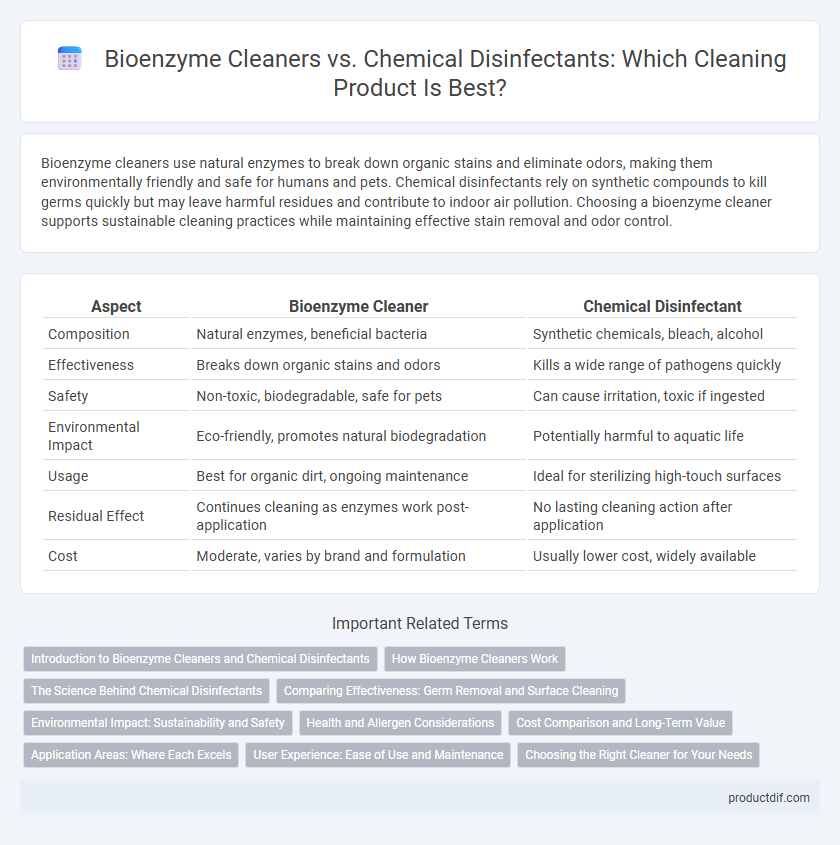Bioenzyme cleaners use natural enzymes to break down organic stains and eliminate odors, making them environmentally friendly and safe for humans and pets. Chemical disinfectants rely on synthetic compounds to kill germs quickly but may leave harmful residues and contribute to indoor air pollution. Choosing a bioenzyme cleaner supports sustainable cleaning practices while maintaining effective stain removal and odor control.
Table of Comparison
| Aspect | Bioenzyme Cleaner | Chemical Disinfectant |
|---|---|---|
| Composition | Natural enzymes, beneficial bacteria | Synthetic chemicals, bleach, alcohol |
| Effectiveness | Breaks down organic stains and odors | Kills a wide range of pathogens quickly |
| Safety | Non-toxic, biodegradable, safe for pets | Can cause irritation, toxic if ingested |
| Environmental Impact | Eco-friendly, promotes natural biodegradation | Potentially harmful to aquatic life |
| Usage | Best for organic dirt, ongoing maintenance | Ideal for sterilizing high-touch surfaces |
| Residual Effect | Continues cleaning as enzymes work post-application | No lasting cleaning action after application |
| Cost | Moderate, varies by brand and formulation | Usually lower cost, widely available |
Introduction to Bioenzyme Cleaners and Chemical Disinfectants
Bioenzyme cleaners utilize natural enzymes to break down organic waste and grease, offering an eco-friendly alternative to chemical disinfectants that rely on synthetic compounds to kill germs and bacteria. These biological agents target specific stains and odors, promoting biodegradability and reducing environmental impact compared to harsh chemical ingredients. Chemical disinfectants provide rapid and broad-spectrum antimicrobial action but may contribute to chemical residues and resistance, whereas bioenzyme cleaners support sustainable cleaning with minimal toxicity.
How Bioenzyme Cleaners Work
Bioenzyme cleaners utilize natural enzymes to break down organic matter such as grease, fats, and food residues at a molecular level, effectively accelerating decomposition and promoting biodegradable waste removal. These cleaners contain specific enzymes like proteases, lipases, and amylases that target proteins, lipids, and carbohydrates, ensuring deeper cleaning without harsh chemicals. Unlike chemical disinfectants that rely on toxic agents to kill bacteria, bioenzyme cleaners support sustainable cleaning by enhancing microbial activity and restoring microbial balance on surfaces.
The Science Behind Chemical Disinfectants
Chemical disinfectants rely on active ingredients like chlorine, quaternary ammonium compounds, and hydrogen peroxide to kill bacteria and viruses by disrupting cell membranes and denaturing proteins. These substances provide rapid antimicrobial action but can also cause surface damage and leave harmful residues. In contrast to bioenzyme cleaners that use natural enzymes to break down organic matter, chemical disinfectants offer broad-spectrum efficacy through potent chemical reactions.
Comparing Effectiveness: Germ Removal and Surface Cleaning
Bioenzyme cleaners break down organic matter at a molecular level, effectively removing germs and grime while being safe for various surfaces and the environment. Chemical disinfectants kill a broad spectrum of pathogens rapidly but may leave harmful residues and cause surface damage over time. Studies show bioenzyme cleaners excel in sustained microbial control and thorough surface cleaning, making them a viable alternative to traditional chemical disinfectants.
Environmental Impact: Sustainability and Safety
Bioenzyme cleaners utilize natural enzymes and beneficial microbes to break down organic matter without releasing harmful chemicals, making them biodegradable and eco-friendly. Chemical disinfectants often contain harsh substances like bleach or ammonia, which can contaminate water sources and contribute to environmental pollution. Choosing bioenzyme cleaners supports sustainability by reducing toxic waste and enhancing safety for both ecosystems and human health.
Health and Allergen Considerations
Bioenzyme cleaners utilize natural enzymes to break down organic matter, reducing exposure to harsh chemicals and lowering the risk of respiratory irritation and allergic reactions. Chemical disinfectants often contain potent substances like bleach and ammonia that may trigger asthma symptoms or skin sensitivities in vulnerable individuals. Choosing bioenzyme cleaners supports a healthier indoor environment by minimizing toxic residues and allergen buildup.
Cost Comparison and Long-Term Value
Bioenzyme cleaners typically offer lower upfront costs due to their natural ingredients and reduced packaging requirements compared to chemical disinfectants. Over time, bioenzyme cleaners provide superior long-term value by enhancing surface longevity and promoting environmental sustainability, whereas chemical disinfectants can cause material degradation and require more frequent application. Investing in bioenzyme cleaners reduces overall expenses related to health risks and surface wear, resulting in cost savings beyond initial purchase prices.
Application Areas: Where Each Excels
Bioenzyme cleaners excel in organic waste removal in kitchens, pet areas, and septic systems by breaking down proteins, fats, and starches at the molecular level. Chemical disinfectants are most effective in healthcare settings, laboratories, and high-touch surfaces, rapidly killing bacteria, viruses, and fungi on contact. Bioenzyme solutions are ideal for environmentally sensitive applications, while chemical disinfectants dominate in sterilization-demanding environments.
User Experience: Ease of Use and Maintenance
Bioenzyme cleaners offer a user-friendly experience with gentle, non-toxic ingredients that minimize skin irritation and require no special storage conditions, enhancing ease of use. Chemical disinfectants often demand careful handling, protective gear, and specific storage to prevent hazards, complicating maintenance routines. The self-sustaining nature of bioenzymes reduces residue buildup, lowering cleaning frequency and preserving surfaces better than harsh chemical agents.
Choosing the Right Cleaner for Your Needs
Bioenzyme cleaners harness natural enzymes and microbes to break down organic matter, making them ideal for eco-friendly and non-toxic cleaning applications in homes with pets or children. Chemical disinfectants offer rapid and broad-spectrum germ elimination, suitable for high-traffic areas requiring stringent sanitation protocols. Selecting the right cleaner depends on balancing the need for environmental safety with the urgency of pathogen control in specific cleaning scenarios.
Bioenzyme cleaner vs chemical disinfectant Infographic

 productdif.com
productdif.com